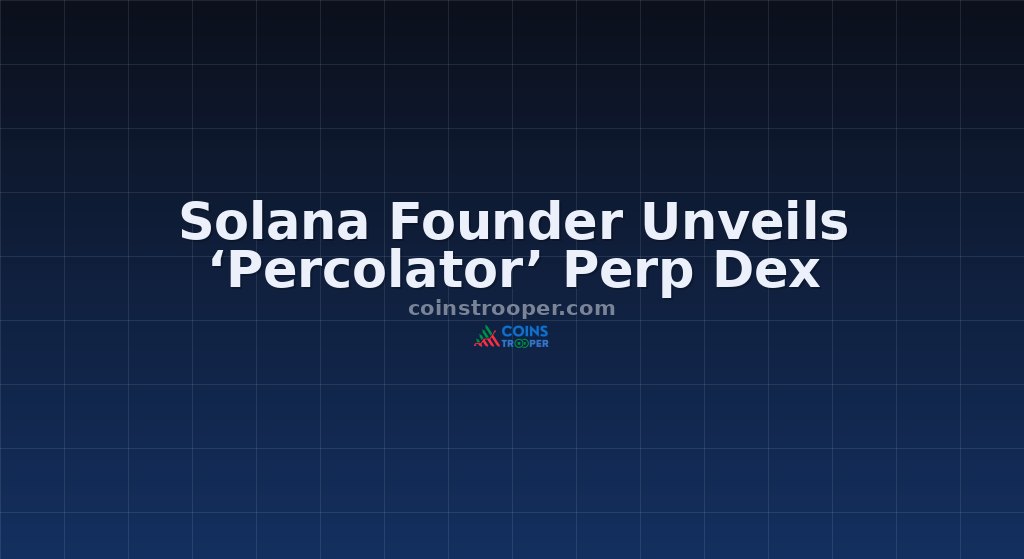Solana Founder Unveils ‘Percolator’ Perp Dex

- Percolator’s emergence comes at an important time for the Solana ecosystem.
- This approach, Yakovenko argues, would prevent congestion during periods of high trading volume, which is a known pain point for many existing DEXs.
- “The design keeps each LP’s slab fully self-contained and innovable,” Yakovenko wrote in his technical summary.
- “Aggregate capital efficiency matches a monolithic DEX, often with better execution quality via selective routing.”
What Happened
Percolator aims to introduce a two-program architecture built for performance and flexibility by featuring a Router program that manages collateral, portfolio margining, and cross-slab routing, alongside modular “Slabs” that serve as self-contained trading engines operated by liquidity providers.
The project’s GitHub files suggest that the system is close to stress-testing, marking a potentially important step for Solana’s DeFi sector.
The timing of the announcement is particularly relevant. Solana has recently lost ground in one of its strongest suits, the meme coin market. Once Solana’s strongest area of user activity, retail interest has waned sharply from the broader meme coin sector following a major crypto sell-off during October.
This downturn has left Solana in need of new growth drivers. Activity on Solana launchpads has also slowed, with weekly trading volumes declining from $1.5 billion in July to around $600 million by late September.
Additionally, Solana has been improving its new network performance. The blockchain recently achieved 623 consecutive days without an outage, its longest operational streak since its launch in 2020, showing the network’s technical maturity.
Market Context
Percolator’s emergence comes at an important time for the Solana ecosystem. Although Solana’s DeFi ecosystem has seen consistent growth, its perpetuals trading sector has lagged behind competitors like Hyperliquid, which have captured a large market share in recent months.
Data shows Solana-based perp DEX volume fell by 24.19% week-on-week, with total monthly volume now around $63.24 billion, reflecting a steady loss of market momentum.
Yakovenko’s move appears to be an effort to bring a new layer of infrastructure that could attract liquidity providers and high-frequency traders seeking decentralized alternatives to centralized exchanges.
According to the documentation, Percolator seeks to deliver CEX-level execution speeds with the multi-shard order books, allowing different trading pairs or markets to run concurrently without competing for the same computational resources.
This approach, Yakovenko argues, would prevent congestion during periods of high trading volume, which is a known pain point for many existing DEXs.
“The design keeps each LP’s slab fully self-contained and innovable,” Yakovenko wrote in his technical summary. “Aggregate capital efficiency matches a monolithic DEX, often with better execution quality via selective routing.”
Although the codebase is still in development, with several processes such as account validation and funding rate updates yet to be finalized, many of the core data structures are already complete.
Over $28 billion in meme token value was wiped out in mid-October, according to a Cryptonews report. The total market capitalization of meme tokens fell from $72 billion to $44 billion, erasing months of gains largely driven by Solana and BNB Chain trading activity.
Against this backdrop, Percolator represents a potential shift, an effort to reassert Solana’s technological edge in decentralized finance by entering the competitive perpetual trading arena.
Perpetual DEX Volume Tops $1.15 Trillion as Solana’s DEX Enters the Arena
Perpetual futures exchanges have become one of the fastest-growing areas in decentralized trading. These platforms allow users to speculate on crypto prices without expiration dates, with on-chain settlement and 24/7 market access.
The sector’s combined 30-day trading volume recently topped $1.15 trillion, according to DeFiLlama, reflecting a rapid migration from centralized exchanges to decentralized derivatives platforms.
Currently, Hyperliquid and Aster dominate the field. Hyperliquid, operating on its own Layer 1 blockchain, commands the deepest liquidity with $7.59 billion in open interest and $309 billion in 30-day trading volume.
The exchange has become a benchmark for speed and execution quality, handling as much as $17 billion in daily trading at its peak this year. Its token, HYPE, carries a market capitalization of roughly $10.2 billion, supported by over $1.19 billion in annualized revenue.
Aster, meanwhile, has emerged as a formidable challenger. Built on BNB Smart Chain with backing linked to Binance co-founder Changpeng “CZ” Zhao, the exchange has leveraged multi-chain support and aggressive incentives to capture new users.
Why It Matters
The GitHub repository for the project was uploaded on October 19, outlining what Yakovenko described as an “implementation-ready” technical blueprint for a sharded perpetual futures decentralized exchange (DEX) that could challenge leading players like Aster and Hyperliquid.
Percolator Could Reignite Solana DeFi as Meme Coin Activity Cools
This enhanced stability could help restore developer and trader confidence as Solana attempts to reestablish its presence in the DeFi ecosystem, something that Percolator can leverage.
Details
Solana co-founder and CEO Anatoly Yakovenko has unveiled a new decentralized perpetual exchange protocol, “Percolator,” designed to run natively on the Solana blockchain.

